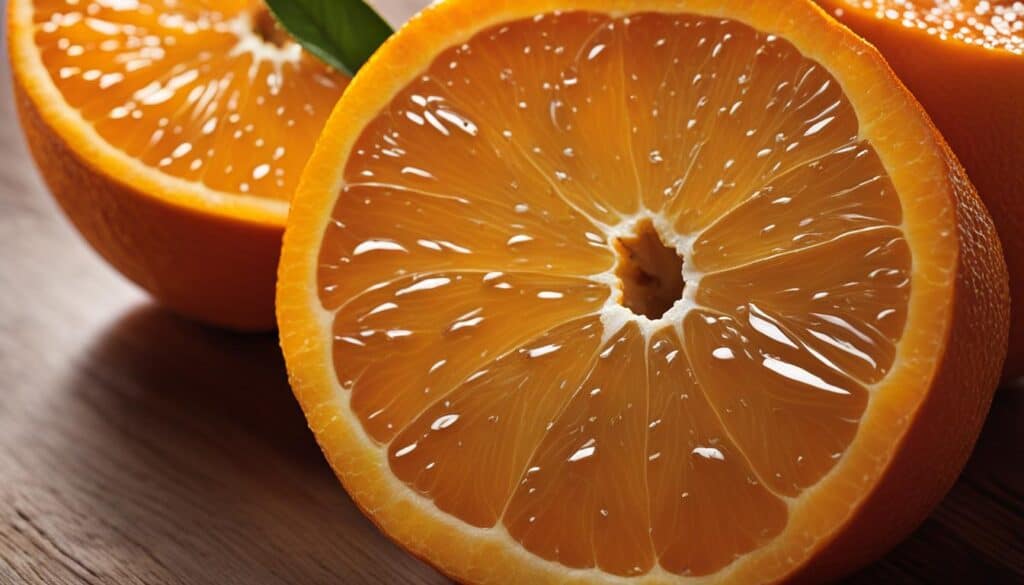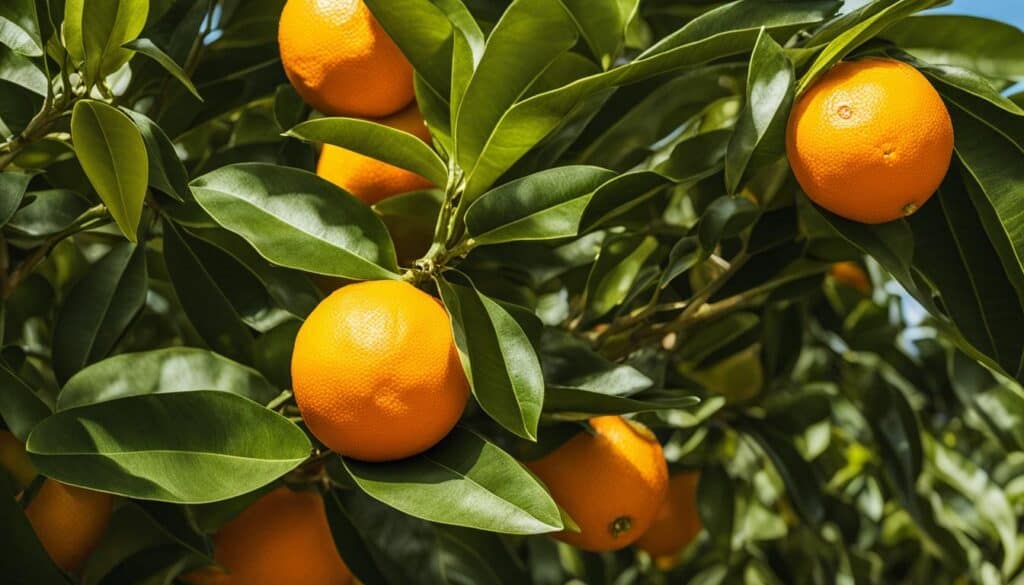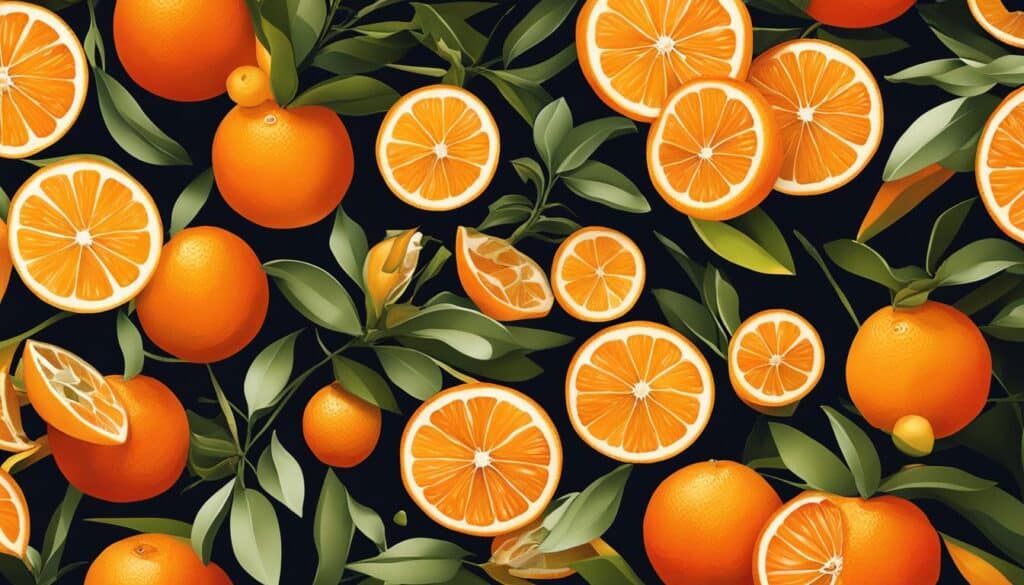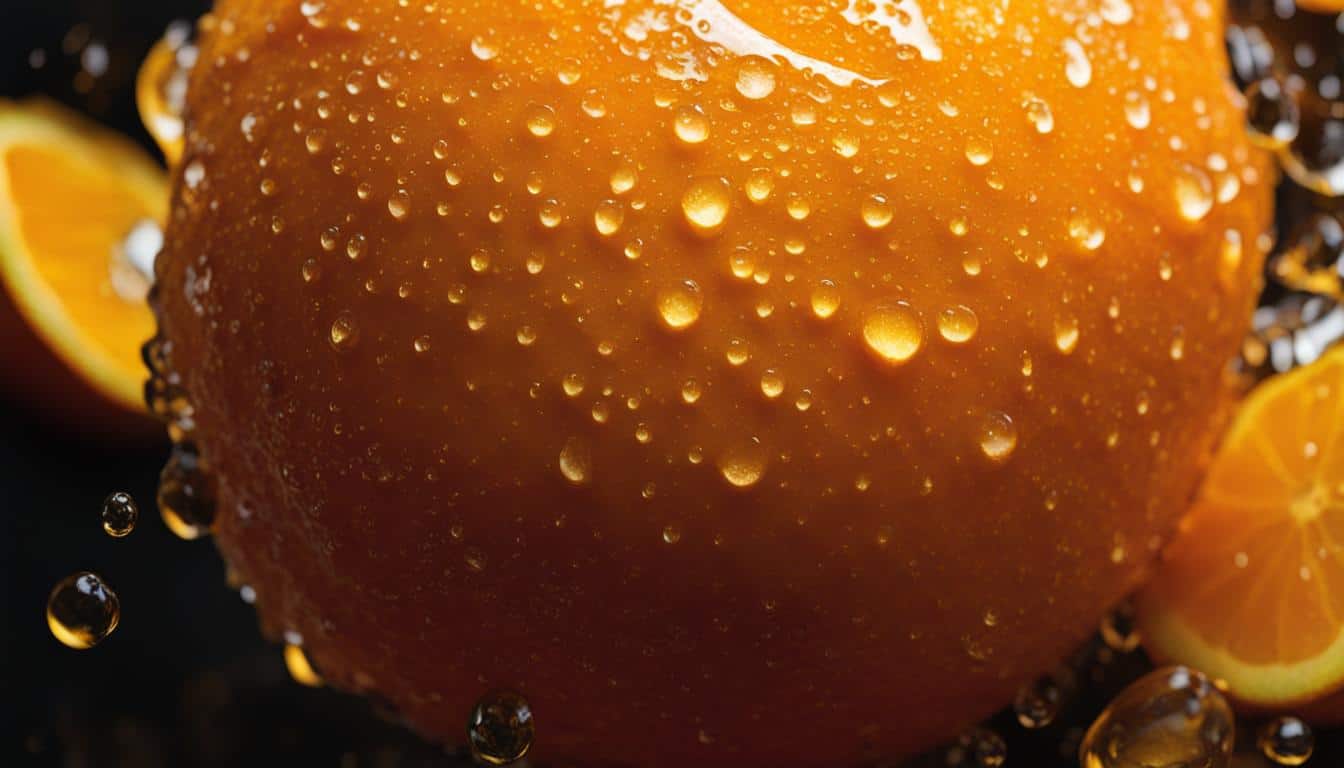Welcome to the fascinating world of Citrus sinensis, commonly known as the sweet orange or orange fruit. As a citrus species belonging to the Rutaceae family, it has captivated people around the globe with its vibrant color, refreshing taste, and numerous health benefits. Native to southeast Asia, the orange tree is now cultivated in many regions, making it a beloved fruit worldwide.
The History and Cultivation of Citrus Sinensis
Citrus sinensis, commonly known as the orange fruit, has a rich history of cultivation that dates back thousands of years. It originated in China and quickly spread to other parts of the world through trade routes. Today, orange cultivation is widespread and can be found in major citrus-producing countries such as Brazil, the United States, and Spain. The orange tree thrives in warm, subtropical climates and requires well-drained soil and plenty of sunlight to grow. It is typically propagated through seeds or grafting onto rootstocks.
Orange cultivation involves a series of careful steps, including planting, irrigation, fertilization, pest control, and harvesting. The trees are grown from seeds or grafted onto rootstocks to ensure desirable characteristics and improved disease resistance. Once planted, the orange trees require regular irrigation to maintain optimal soil moisture levels. Fertilizers are applied to provide essential nutrients for growth and fruit development. Pest control measures are implemented to protect the trees from insects and diseases. Harvesting takes place when the oranges are fully ripe, and they can be stored for several weeks or processed into various products, such as juice, jams, and desserts.
Overall, the history and cultivation of Citrus sinensis are a testament to human ingenuity and the enduring popularity of this delicious and versatile fruit.
Historical Timeline of Citrus Sinensis Cultivation
| Year | Event |
|---|---|
| 3000 BCE | Orange cultivation begins in China |
| 700 BCE | Oranges introduced to India and Persia |
| 14th century | Orange cultivation spreads to Europe through trade routes |
| 16th century | Oranges brought to the Americas by Spanish explorers |
| 19th century | Commercial orange cultivation begins in Florida, USA |
“Citrus sinensis has a fascinating history of cultivation, spanning thousands of years and continents. It has become deeply intertwined with human culture and has played a significant role in trade, exploration, and culinary traditions. The cultivation of Citrus sinensis continues to evolve, driven by advances in agricultural practices and the demand for this beloved fruit.”
The Beauty of Orange Cultivation
- Orange trees thrive in warm, subtropical climates.
- They require well-drained soil and plenty of sunlight.
- The cultivation process involves planting, irrigation, fertilization, pest control, and harvesting.
- Orange trees can be propagated through seeds or grafting onto rootstocks.
- Harvesting takes place when the oranges are fully ripe and can be stored or processed into various products.
Orange cultivation is not just a method of growing a fruit; it is an art that requires knowledge, skill, and dedication. From ancient China to modern citrus farms, the cultivation of Citrus sinensis has been an ongoing journey of discovery, innovation, and appreciation of nature’s bounty.
Orange Varieties: Exploring the Diversity of Citrus Sinensis
When it comes to Citrus Sinensis, or oranges, there is an incredible diversity of varieties to explore. Each with its own unique characteristics, these orange varieties offer a range of flavors, colors, and culinary possibilities. From the popular Navel orange to the tangy Blood orange and the sweet Mandarin orange, there is an orange variety to suit every taste.
Table:
| Variety | Characteristics | Flavor | Culinary Uses |
|---|---|---|---|
| Navel Orange | Seedless, distinctive “navel” at the blossom end | Sweet, slightly acidic | Best for fresh eating, salads |
| Valencia Orange | Thin-skinned, very juicy | Sweet, tangy | Ideal for juicing, desserts |
| Blood Orange | Deep red or purple flesh | Sweet, tangy | Perfect for salads, cocktails |
| Mandarin Orange (Tangerine) | Small, easy-to-peel | Sweet, mild | Great for snacking, baking |
These are just a few examples of the many orange varieties available. Other varieties, such as Hamlin, Pineapple, and Cara Cara oranges, offer their own unique flavor profiles and culinary uses. Whether you’re looking for a sweet and juicy orange or a tangy and vibrant one, there is a variety of Citrus Sinensis to satisfy your taste buds.
The beauty of exploring orange varieties is that it allows you to experiment with different flavors and textures in your culinary creations. From refreshing salads and desserts to zesty marinades and baked goods, oranges can elevate any dish with their bright and citrusy notes. So, why not embrace the diversity of Citrus Sinensis and embark on a culinary adventure with these versatile and delicious orange varieties?
Nutritional Benefits of Citrus Sinensis: A Burst of Vitamin C

Citrus sinensis, or oranges, are not just a delicious and refreshing fruit; they also offer a myriad of nutritional benefits. One of the key nutrients found in oranges is vitamin C, which plays a crucial role in supporting immune function and overall health.
Just one orange provides approximately 116% of the recommended daily intake of vitamin C, making it an excellent choice for boosting your immune system. Vitamin C is an essential antioxidant that helps protect cells from damage, supports collagen production for healthy skin and joints, and aids in the absorption of iron.
In addition to being rich in vitamin C, oranges are also a good source of dietary fiber. Fiber is important for maintaining healthy digestion, regulating blood sugar levels, and promoting a feeling of fullness. Oranges are also low in calories and contain a variety of other vitamins and minerals, including vitamin A, potassium, and folate.
The Nutritional Composition of Oranges
| Nutrient | Amount per 100g |
|---|---|
| Calories | 43 |
| Carbohydrates | 9g |
| Fiber | 2g |
| Sugar | 9g |
| Vitamin C | 53.2mg |
| Vitamin A | 225IU |
| Potassium | 181mg |
With their high vitamin C content, fiber, and array of other nutrients, oranges are a nutritious and delicious addition to any diet. Whether eaten fresh, juiced, or incorporated into various recipes, oranges provide a burst of flavor and essential nutrients to support your overall well-being.
The Culinary Delights of Citrus Sinensis: From Fresh Juice to Zesty Recipes
When it comes to culinary versatility, Citrus sinensis, or oranges, take the spotlight. From their juicy flesh to their tangy flavor, oranges offer a burst of citrus goodness that can elevate any dish. Whether you’re craving a refreshing glass of orange juice or looking to experiment with zesty recipes, oranges have got you covered.
One of the simplest ways to enjoy the culinary delights of Citrus sinensis is to savor a glass of freshly squeezed orange juice. The vibrant color and refreshing taste of oranges make them a popular choice for juicing. Whether enjoyed on their own or mixed into smoothies or cocktails, orange juice adds a citrusy twist to your favorite beverages.
But oranges aren’t just limited to beverages. They can also be used in a wide range of sweet and savory recipes. From salads and desserts to marinades and glazes, oranges bring a vibrant burst of flavor to every bite. Try adding segments of oranges to a salad for a refreshing and tangy twist, or use orange zest to infuse baked goods with a citrusy aroma.
| Orange Recipe Ideas | Description |
|---|---|
| Orange Glazed Salmon | Grilled salmon topped with a tangy orange glaze, creating a perfect balance of sweet and savory flavors. |
| Orange Upside-Down Cake | A delicious twist on the classic pineapple upside-down cake, with orange slices caramelized in a buttery brown sugar glaze. |
| Orange, Fennel, and Arugula Salad | A refreshing salad featuring a combination of crisp arugula, sweet oranges, and the subtle licorice flavor of fennel. |
So, whether you’re looking to quench your thirst with a glass of fresh orange juice or add a citrusy kick to your favorite recipes, Citrus sinensis is your go-to ingredient. Explore the culinary delights of oranges and let their vibrant flavor elevate your dishes to new heights.
Health Benefits of Citrus Sinensis: Boosting Immunity and Overall Wellness

When it comes to health benefits, Citrus sinensis, or oranges, are a true powerhouse. Packed with essential nutrients, oranges can significantly contribute to boosting immunity and promoting overall wellness. One of the key factors that make oranges so beneficial is their high vitamin C content. Vitamin C plays a crucial role in strengthening the immune system, reducing the risk of colds, flu, and other illnesses. With a single orange providing about 116% of the recommended daily intake of vitamin C, incorporating oranges into your diet can help keep your immune system strong and resilient.
But the benefits don’t stop there. Oranges are also rich in antioxidants, which help protect against oxidative stress and inflammation. These antioxidants contribute to heart health and reduce the risk of chronic diseases. Additionally, oranges are a great source of dietary fiber, aiding in digestion, supporting weight management, and helping to lower cholesterol levels. Furthermore, oranges are hydrating and contain electrolytes, making them a perfect choice for staying hydrated, particularly during hot weather or physical activity.
Incorporating Citrus sinensis into a balanced diet can have a significant impact on overall wellness. From boosting immunity to promoting heart health and aiding digestion, oranges offer a wide range of health benefits that make them a valuable addition to any diet. So why not enjoy a juicy orange today and reap the numerous benefits it has to offer.
Health Benefits of Citrus Sinensis: A Summary
- High in vitamin C, which strengthens the immune system.
- Rich in antioxidants, which protect against oxidative stress and inflammation, promoting heart health and reducing the risk of chronic diseases.
- A good source of dietary fiber, aiding in digestion, supporting weight management, and helping to lower cholesterol levels.
- Hydrating and containing electrolytes, making them an excellent choice for staying hydrated during hot weather or physical activity.
The Cultural Significance of Citrus Sinensis: From Festivals to Symbolism
Citrus sinensis, also known as the orange fruit, holds great cultural significance in many societies around the world. From ancient civilizations to modern traditions, oranges have been associated with various symbolic meanings and celebrated during festivals and ceremonies.
In some cultures, oranges are regarded as a symbol of good luck, prosperity, and happiness. They are often exchanged as gifts during festive occasions, such as the Chinese New Year and Christmas. The vibrant color and sweet aroma of oranges bring joy and positive energy to these celebrations.
Furthermore, oranges are used in religious rituals and ceremonies. Their fragrant blossoms are incorporated into religious offerings, symbolizing purity and divine blessings. The orange tree itself is considered a representation of fertility, abundance, and longevity.
“Oranges are like sunshine that brighten our lives and bring blessings of joy and prosperity.” – Anonymous
The cultural significance of Citrus sinensis can be seen in art, literature, and folklore throughout history. Paintings often feature oranges as a symbol of beauty, vitality, and natural abundance. In ancient myths and legends, oranges are depicted as sacred fruits, possessing mystical properties.
| Cultural Symbol | Meaning |
|---|---|
| Good Luck | Oranges are believed to bring fortune and positive energy. |
| Prosperity | Oranges are associated with wealth, abundance, and success. |
| Happiness | Oranges bring joy, laughter, and a sense of well-being. |
| Fertility | The orange tree symbolizes growth, vitality, and the cycle of life. |
| Longevity | The orange tree represents a long and prosperous life. |
The cultural significance of Citrus sinensis continues to be cherished and celebrated, reflecting the enduring fascination and importance of oranges in human society.
Citrus Sinensis: A Garden Treasure for Citrus Enthusiasts

As a passionate citrus enthusiast, I can confidently say that growing Citrus sinensis, also known as orange trees or citrus trees, is an absolute delight. These trees not only add beauty to any garden with their attractive evergreen foliage and fragrant flowers but also provide a bountiful supply of delicious oranges. Whether you have a spacious garden or limited space for potted plants, you can easily cultivate these garden treasures and enjoy the satisfaction of growing your own food.
Orange trees thrive in areas with abundant sunlight, making them an excellent choice for gardens in warm climates. They require well-drained soil and regular watering to ensure their health and productivity. The versatility of orange trees allows you to grow them in pots, making them suitable for urban gardening or small spaces. Just imagine the joy of stepping out into your garden and plucking fresh, juicy oranges straight from the tree.
Aside from the sheer pleasure of nurturing and harvesting your own oranges, growing Citrus sinensis offers a deeper connection with nature. It allows you to witness the beautiful process of fruit development and gain a greater appreciation for the natural world. The oranges you grow can be enjoyed fresh or used in a variety of culinary creations, adding a burst of citrus flavor to salads, desserts, and even savory dishes.
So, whether you’re an experienced gardener or just starting out, I highly recommend adding Citrus sinensis to your garden. The satisfaction of cultivating these garden treasures, the joy of plucking your own juicy oranges, and the connection with nature make it a truly rewarding experience. So why not embark on this citrus adventure and discover the wonders of Citrus sinensis for yourself?
Citrus Sinensis in Perfumery and Aromatherapy: The Aromatic Allure of Orange

When it comes to the captivating world of perfumery and aromatherapy, Citrus sinensis, particularly the orange fruit and blossoms, takes center stage with its distinct and pleasing aroma. The essential oil extracted from orange peels is commonly used as a fragrance component in perfumes, colognes, and scented products. Its revitalizing and uplifting scent adds a delightful sensory experience to any space.
In aromatherapy, the aroma of oranges is valued for its mood-enhancing and stress-relieving properties. The invigorating fragrance of orange essential oil is known to evoke feelings of energy, warmth, and positivity. Whether used in the form of essential oils, scented candles, or natural air fresheners, Citrus sinensis adds an alluring touch to enhance relaxation and well-being.
“The invigorating fragrance of orange essential oil is known to evoke feelings of energy, warmth, and positivity.”
Incorporating Citrus sinensis into perfumery and aromatherapy is a testament to the aromatic allure of oranges. The sweet and refreshing scent of oranges has a wide appeal, creating a harmonious and uplifting atmosphere wherever it is utilized. From luxury fragrances to personal wellness rituals, Citrus sinensis continues to captivate and invigorate with its aromatic charm.
The Aromatic Allure of Orange in Perfumery and Aromatherapy
When it comes to fragrance, the aroma of oranges holds an esteemed position. Orange essential oil, derived from Citrus sinensis, is a popular ingredient in the perfume industry. Its bright, zesty, and refreshing scent adds a vibrant and enticing note to fragrances. The aroma of orange is often associated with feelings of joy, warmth, and positivity, making it a sought-after ingredient in perfumes and colognes.
In aromatherapy, the aroma of orange is cherished for its uplifting and invigorating properties. The scent of orange essential oil is believed to boost mood, reduce stress, and promote relaxation. It is often used in diffusers, massage oils, and bath products to create a rejuvenating and soothing ambiance. The aroma of orange in aromatherapy is like a ray of sunshine, bringing a sense of happiness and well-being.
“The aroma of orange in aromatherapy is like a ray of sunshine, bringing a sense of happiness and well-being.”
The aromatic allure of orange extends beyond the fragrance industry and aromatherapy. Orange-scented candles, room sprays, and potpourri are popular choices for creating a pleasant and inviting atmosphere in homes and spaces. The sweet and tangy aroma of oranges has a universal appeal, evoking a sense of freshness and vitality.
Whether it’s the lingering scent of a perfume, the invigorating atmosphere of an aromatherapy session, or the welcoming fragrance of a scented candle, the aromatic allure of Citrus sinensis adds a touch of vibrancy and serenity to our lives.
Incorporating the Aromatic Allure of Orange into Perfumery and Aromatherapy
The aromatic allure of orange, derived from Citrus sinensis, has long been cherished in the realms of perfumery and aromatherapy. Perfumers harness the distinct scent of orange essential oil to create fragrances that range from fresh and citrusy to warm and sensual. The aroma of orange adds a bright and uplifting quality to perfumes, making them captivating and memorable.
- Perfumes and colognes: Orange essential oil is often blended with other complementary notes to create unique and enticing fragrances. Its lively and invigorating scent can be found in both feminine and masculine perfumes, adding a touch of vibrancy and energy.
- Scented personal care products: From body lotions and shower gels to shampoo and conditioner, the aroma of oranges is a popular choice for adding a refreshing and revitalizing experience to personal care routines. The scent of orange lingers on the skin and hair, providing a lasting fragrance.
- Aromatherapy oils and diffusers: The sweet and citrusy scent of orange essential oil is widely used in aromatherapy for its mood-enhancing and stress-reducing properties. Adding a few drops of orange essential oil to a diffuser creates an inviting and uplifting atmosphere, promoting relaxation and well-being.
Whether it’s the captivating allure of an orange-scented perfume or the therapeutic benefits of orange essential oil in aromatherapy, Citrus sinensis continues to enchant and inspire with its aromatic qualities.
| Perfumery | Aromatherapy |
|---|---|
| Orange essential oil is used in a wide range of perfumes and colognes, adding a vibrant and invigorating note to the fragrance. | Orange essential oil is valued in aromatherapy for its mood-enhancing and stress-relieving properties. It is often used in diffusers, massage oils, and bath products to create a serene and uplifting ambiance. |
| Perfumes and colognes with an orange note are popular choices for those seeking a fresh and uplifting fragrance. | Orange essential oil is known to promote relaxation and well-being, making it a beloved choice for aromatherapy rituals. |
| The aroma of orange in perfumes can evoke feelings of joy, energy, and positivity. | The scent of orange in aromatherapy is like a burst of sunshine, bringing a sense of happiness and rejuvenation. |
The Environmental Impact of Citrus Sinensis: Sustainable Citrus Farming Practices

Citrus Sinensis, or oranges, are beloved by many for their vibrant color, refreshing taste, and numerous health benefits. However, the cultivation of Citrus Sinensis has environmental implications that need to be addressed. Sustainable citrus farming practices aim to minimize the negative impact on the environment while maximizing crop productivity. By adopting these practices, citrus growers can contribute to environmental stewardship and protect the natural resources that support the cultivation of Citrus Sinensis.
Organic Farming
One of the key sustainable farming practices for Citrus Sinensis is organic farming. This method avoids the use of synthetic pesticides and fertilizers, promoting soil health and reducing chemical runoff. Organic farming relies on natural fertilizers, such as compost and manure, and employs techniques like crop rotation and cover cropping to maintain soil fertility. By prioritizing soil health, organic farming enhances the overall sustainability of citrus cultivation.
Integrated Pest Management
Another important practice is integrated pest management (IPM). IPM involves the use of natural predators, such as ladybugs and predatory mites, to control pests and limit the use of chemical pesticides. This approach focuses on monitoring pest populations, employing biological control methods, and utilizing selective pesticides only when necessary. By reducing reliance on chemical pesticides, IPM helps maintain a healthy ecosystem and minimizes potential harm to beneficial insects and organisms.
Water and Soil Conservation
Water and soil conservation are crucial aspects of sustainable citrus farming. Efficient irrigation techniques, such as drip irrigation and micro-sprinklers, help conserve water by delivering it directly to the roots of the plants. Additionally, farmers can implement water recycling systems to reuse and conserve water resources. Soil conservation practices, like proper erosion control and maintaining ground cover, help prevent soil degradation and nutrient loss. By conserving water and promoting soil health, citrus growers can contribute to a more sustainable agricultural system.
| Sustainable Citrus Farming Practices for Citrus Sinensis | Benefits |
|---|---|
| Organic Farming | Promotes soil health and reduces chemical runoff |
| Integrated Pest Management | Reduces reliance on chemical pesticides and maintains a healthy ecosystem |
| Water and Soil Conservation | Conserves water resources and promotes soil health |
Implementing sustainable farming practices for Citrus Sinensis is essential for the long-term viability of orange cultivation. By focusing on organic farming, integrated pest management, and water and soil conservation, citrus growers can minimize the environmental impact associated with citrus farming while ensuring the continued availability of this beloved fruit.
The Future of Citrus Sinensis: Challenges and Innovations in the Citrus Industry
Citrus sinensis, or oranges, have played a significant role in our lives for centuries. However, the citrus industry faces numerous challenges and must continually innovate to ensure the sustainability and growth of Citrus sinensis cultivation. From climate change to disease outbreaks, the industry must adapt to overcome these obstacles and meet the evolving demands of consumers.
One of the major challenges facing the citrus industry is climate change. Rising temperatures and changing weather patterns can have detrimental effects on citrus crops, impacting their growth, yield, and quality. Citrus growers are exploring various strategies to mitigate these effects, such as implementing advanced irrigation techniques, developing heat-tolerant citrus varieties, and adopting sustainable farming practices that promote resilience and adaptability.
Another challenge the citrus industry faces is disease outbreaks, particularly the threat of citrus greening disease. This devastating disease is caused by the bacteria Candidatus Liberibacter spp. and affects the health and productivity of citrus trees. Researchers and growers are actively working to develop disease-resistant varieties, implement stringent pest control measures, and enhance biosecurity protocols to prevent the spread of citrus greening and other harmful diseases.
In addition to addressing these challenges, the citrus industry is also embracing innovation to stay competitive and meet consumer demands. Advancements in technology, such as precision agriculture and automation, are revolutionizing citrus cultivation practices, improving efficiency, and reducing resource usage. Furthermore, there is a growing interest in developing new citrus varieties with unique flavors, textures, and nutritional profiles to cater to diverse consumer preferences.
The future of Citrus sinensis relies on the collective efforts of researchers, growers, and industry stakeholders to overcome challenges and drive innovation in the citrus industry. By adopting sustainable practices, harnessing technological advancements, and promoting collaboration, we can ensure the continued availability and enjoyment of this beloved fruit for generations to come.
Conclusion
Citrus sinensis, or oranges, are a true wonder of nature, delighting our senses with their vibrant color, juicy flesh, and refreshing taste. These citrus fruits offer a plethora of health benefits, culinary possibilities, and cultural significance that have charmed and nourished humanity for centuries.
From the fascinating history and cultivation of Citrus sinensis to its incredible nutritional value and aromatic allure, these fruits have become an integral part of our lives. With their high vitamin C content and numerous antioxidants, oranges contribute to our overall well-being and help boost our immune systems.
As we look to the future, it is crucial that we promote sustainable practices and innovation in the citrus industry. By adopting organic farming methods, conserving water, and developing disease-resistant citrus varieties, we can ensure the continued availability and enjoyment of Citrus sinensis for generations to come.
So, let us keep savoring the juicy tales and exciting benefits of this citrus wonder, the beloved Citrus sinensis. Whether in our daily diet, our favorite recipes, or the cultural traditions that celebrate its presence, Citrus sinensis continues to bring joy, health, and flavor to our lives.
FAQ
What is Citrus sinensis?
Citrus sinensis, commonly known as the sweet orange or orange fruit, is a citrus species that belongs to the Rutaceae family.
Where is Citrus sinensis native to?
Citrus sinensis is native to southeast Asia.
Are there different varieties of oranges?
Yes, there are various varieties of oranges, including Navel, Valencia, Blood, and Mandarin oranges.
Why are oranges known for their health benefits?
Oranges are rich in vitamin C, antioxidants, and fiber, making them a nutritious addition to any diet.
How long has Citrus sinensis been cultivated?
Citrus sinensis has a long history of cultivation, dating back thousands of years.
Where are oranges cultivated today?
Oranges are cultivated in many regions around the world, with major producers including Brazil, the United States, and Spain.
What are the culinary uses of oranges?
Oranges can be used in both sweet and savory recipes, adding a burst of citrus flavor to salads, baked goods, marinades, and more.
What health benefits do oranges offer?
Oranges are packed with essential nutrients, including high levels of vitamin C, which can boost the immune system and promote collagen production. They also contain fiber, vitamins, and minerals.
What is the cultural significance of oranges?
Oranges are associated with good luck, prosperity, and happiness in many cultures and are prominently featured during festive occasions.
Can I grow my own orange tree?
Yes, orange trees can be grown in home gardens and provide a fresh supply of oranges for personal consumption.
What is the aroma of Citrus sinensis used for?
The aroma of Citrus sinensis, particularly the orange fruit and blossoms, is utilized in perfumery and aromatherapy for its revitalizing and uplifting scent.
How can orange cultivation be sustainable?
Sustainable citrus farming practices focus on organic farming, integrated pest management, water conservation, soil conservation, and biodiversity preservation.
What are the challenges faced by the citrus industry?
The citrus industry is affected by factors such as climate change, disease outbreaks, pests, market trends, and globalization, requiring innovative solutions to overcome these challenges.





Leave a Reply